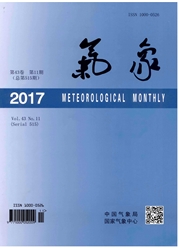

 中文摘要:
中文摘要:
针对台风业务应用中发现FY-2D和FY-2E双星观测存在亮温差过大的问题,本文以2010年台风鲇鱼(Megi)为例,利用2010年10月17日1030-1230UTC的FY-2D/E红外1通道数据,提出了双星亮温归一化的解决方法,结果如下:(1)采用CDF(Cumulative Distribution Function)匹配法对双星亮温进行归一化处理,可有效利用FY-2D和FY-2E双星观测结果。个例分析表明,经归一化处理以后,双星的PDF(Probability Distribution Function)分布更趋一致,甚至在很多地方出现重合,归一化效果良好。在台风定强分析,如ADT(Advanced Dvorak Technique)算法中,归一化处理可作为数据预处理的一部分内容,不影响后面的算法和流程。(2)以MTSAT为基准,经CDF匹配法对FY-2D和2E的TBB分别进行归一化处理,将使得FY-2的亮温与MTSAT具有可比性,便于比较国内外的台风定强分析结果和算法差异。
 英文摘要:
英文摘要:
Since typhoon operational monitoring found a large difference of infrared cloud top temperatures (TBB) between geostationary FY-2D and FY-2E satellites in a region of overlap, it is necessary to find a solution to typhoon intensity estimation by using both FY-2D/E satellites. For this motivation, the cumu- lative distribution function (CDF) matching algorithm, which uses the 10.3--11.3 # channel TBB of FY- 2D/E, is introduced to solve the problem. Case study of typhoon Megi, which is chosen for testing the al- gorithm during 1030-1230 UTC 17 October 2010, shows results as below: (1) The CDF matching algo- rithm works well to reduce the difference of FY-2D/E TBB, and depicts more consistent distribution of the probability distribution function (PDF). When estimating typhoon intensity, the CDF matching algorithm can perform independently with satellite data before going step by step to the intensity estimation scheme. For example, the Advanced Dvorak Technique (ADT) can directly use this normalized TBB as input data without any code modification. (2) Given MTSAT TBB as reference and FY-2D/E TBB as candidates, the CDF matching algorithm provides a normalized TBB of FY-2 D/E. Therefore, the typhoon intensity esti- mation by FY-2 DIE TBB only can be comparative with those from MTSAT, and this algorithm can also be checked.
 同期刊论文项目
同期刊论文项目
 同项目期刊论文
同项目期刊论文
 期刊信息
期刊信息
